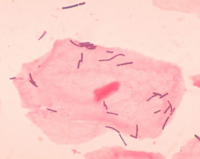Lactobacillus acidophilus: Difference between revisions
imported>Omar Qureshi No edit summary |
imported>Omar Qureshi No edit summary |
||
| Line 24: | Line 24: | ||
==Genome structure== | ==Genome structure== | ||
The complete genome of ''Lactobacillus acidophilus'' NCFM contains 1,993,564 nucleotides and has no plasmids. Its average GC content is 34.71% and 1,864 ORFs were predicted. 72.5% of the ORFs were classified as functional. | The complete genome of ''Lactobacillus acidophilus'' NCFM contains 1,993,564 nucleotides and has no plasmids. Its average GC content is 34.71% and 1,864 ORFs were predicted. 72.5% of the ORFs were classified as functional.<ref>http://www.pnas.org/content/102/11/3906.full.pdf+html</ref> | ||
| Line 53: | Line 53: | ||
http://www.jacn.org/cgi/reprint/18/1/43.pdf [http://www.jacn.org/cgi/reprint/18/1/43.pdf] | http://www.jacn.org/cgi/reprint/18/1/43.pdf [http://www.jacn.org/cgi/reprint/18/1/43.pdf] | ||
http://www.pnas.org/content/102/11/3906.full.pdf+html [http://www.pnas.org/content/102/11/3906.full.pdf+html] | |||
Revision as of 23:24, 21 April 2009
For the course duration, the article is closed to outside editing. Of course you can always leave comments on the discussion page. The anticipated date of course completion is May 21, 2009. One month after that date at the latest, this notice shall be removed. Besides, many other Citizendium articles welcome your collaboration! |
| Lactobacillus acidophilus | ||||||||||||||
|---|---|---|---|---|---|---|---|---|---|---|---|---|---|---|
 | ||||||||||||||
| Scientific classification | ||||||||||||||
| ||||||||||||||
| Binomial name | ||||||||||||||
| Lactobacillus acidophilus |
Description and significance
Lactobacillus acidophilus is a species of gram-positive bacteria commonly used in dairy production. L. acidophilus is also one of the most common forms of probiotics, which are "friendly bacteria".[1] L. acidophilus is found in the human and animal gut, mouth, and vagina. It functions as a lactic acid producer, by metabolizing lactose to lactic acid. The acid produced by L. acidophilus can control the growth of the fungus Candida albicans, which is the cause of Oral thrush and vaginal yeast infections.[2] The acid produced can also prevent unwanted organisms living in the gut. L. acidophilus is commonly used in the production of yogurt, where it is labeled as an active or live culture. People that are lactose intolerant are able to digest dairy products containing L. acidophilus better than dairy products without it.[3] Selected strains of L. acidophilus have shown significant reductions of cholesterol in humans, lowering the risk of coronary heart disease.[4]
Genome structure
The complete genome of Lactobacillus acidophilus NCFM contains 1,993,564 nucleotides and has no plasmids. Its average GC content is 34.71% and 1,864 ORFs were predicted. 72.5% of the ORFs were classified as functional.[5]
Cell structure and metabolism
Ecology
Pathology
Application to Biotechnology
Current Research
References
http://www.umm.edu/altmed/articles/lactobacillus-acidophilus-000310.htm [1]
http://jds.fass.org/cgi/reprint/63/5/830.pdf [2]
http://jds.fass.org/cgi/content/abstract/66/5/959 [3]